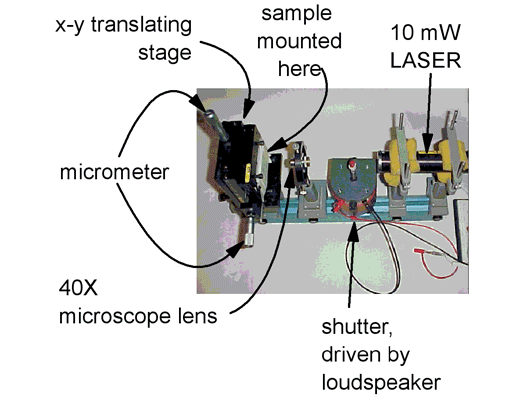Experiment of The Month
Perseverance and Bismuth
In the 1980's IBM engineers used the best lithographic methods of the time to make rings of gold about 1 micron in diameter. IBM physicists passed an electrical current from the left side of a ring to the right, flowing on both the upper and lower half of the ring. By applying a magnetic field they demonstrated and studied a quantum effect called the Aharonov-Bohm effect. It has been a goal of Dr. Dooley to replicate this experiment using equipment available in the Millersville undergraduate physics labs.
Over the years, several students have worked on one aspect of this project; making metal rings of small diameter. Elise Schlager, (MU physics, 1989) succeeded in using our excimer laser to drill holes that were a fraction of a millimeter in diameter in aluminum films deposited on glass substrates. If we could make these smaller, an array of holes in metal film would be equivalent to an array of metal rings.
Anthony Jackson (MU physics, 2002) succeeded in drilling 10 micron holes in carbon paper with a 5 mW HeNe laser. In the summer of 2003, John Schreck (MU physics 2005) used a 10 mW HeNe laser (obtained for Dr. Gilani's research) to drill 10 micron holes in thin black plastic. We then plated the plastic with gold to make our first 10 micron metal ring array. The gold did not adhere well to the plastic; it has been difficult to make electrical contact with the film without scraping it off.
In the winter of 2004, Christopher Kunkle (MU physics 2004) attempted to use the 10 mW laser to drill holes directly in a film of gold evaporated onto glass, much as we had done using the high powered excimer laser for aluminum on glass. The 10 mW laser was unable to penetrate the gold film. The gold is highly reflective, so not all of the light energy was deposited in the metal. The gold, bonded to glass conducts heat well and makes it difficult to deliver enough heat to cause melting.
A second approach used a semimetal, bismuth (Bi) that we had evaporated onto a sheet of transparent plastic. We were encourage by the good adherence of the Bi to the substrate. The Bi film showed good electrical continuity, and was resistant to scraping when we touched Ohm-meter leads to the film.
Bi has higher electrical resistivity than gold, and is a poorer reflector of light, as a consequence. Bi is also a poorer heat conductor than gold. We hoped that the poor reflectivity would result in more rapid energy absorption and heating of the Bi film, when concentrated light was shined upon it. With this heating, we hoped to melt (or burn - we work in the open air) holes in the Bi film.
Chris used the same apparatus as John Schreck, shown below


The sample is mounted on an x-y translating stage. Laser light exposure is controlled electronically with a shutter. A microscope lens focuses the light onto the sample. After a hole has been drilled, light is visible through the left side through a hole in the translating stage. The stage is moved to a new position and a new hole is drilled, with the process repeated to make an array of holes.
The micrograph to the right shows a segment of the array of holes that Chris drilled. The separation of the holes along a horizontal axis is approximately .0025cm, or 25 microns. Rough comparison of the apparent hole diameter with hole separation indicates that the diameter of the holes is on the order of 5 micron.
We would not have this array had not Chris gone back to try again with the drilling apparatus. It turns out that the laser has just enough power to penetrate the Bi when the room is warm. When the room is cold, the cold Bi around the spot being drilled absorbs heat fast enough to prevent drilling. The short term solution was to warm the samples with an ordinary incandescent lamp, while the laser was drilling.
-
Contact Information
Contact Number: 717-871-4297
Email: physics@millersville.edu